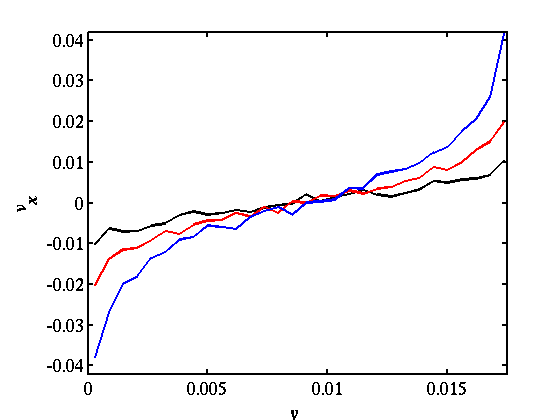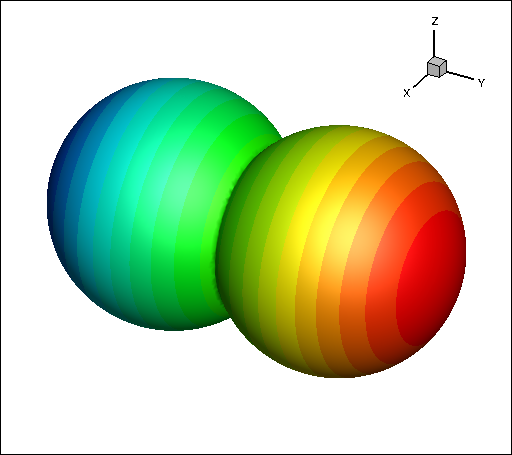Dear lammps users,
It sent this message yesterday but seems that the email was not sent
correctly and the thread is empty. So I am sorry if you are recieving
this for the second time.
I'm trying to simulate shear flow of non-spherical
particles (dumbblle shape) using fix rigid and granular package
(version: 9-Oct).
The particles are create from two overlapping spheres (see attached
figure) and initially configured in a 25x25x25 lattice (using pizza.py)
with a vol fraction of 0.6
I am using the following script for my simulation
units si
atom_style sphere
boundary p p p
newton off
comm_modify mode single vel yes
#Read the Cluster of compound particles and add mol property
fix addMolecule all property/atom mol ghost yes
read_data dumbells.dat fix addMolecule NULL Molecules
#Relax the particles
pair_style gran/hooke/history 2000 NULL 50 NULL 1 0
pair_coeff * *
velocity all create 1e15 1234 loop geom
neighbor 0.003 bin
neigh_modify delay 0 every 1 check yes
timestep 1e-5
fix 1 all rigid molecule
run 30000
#Remove Previous Settings
unfix 1
uncompute 1
uncompute 2
reset_timestep 0
#New Seetings
change_box all triclinic remap
pair_style gran/hooke/history 2000 NULL 50 NULL 0.5 1
pair_coeff * *
timestep 1e-5
fix 1 all rigid molecule
fix shearRun all deform 1 xy erate ${shearRate} remap v units box
run ${NSTEPS}
I expect to get a linear velocity profile but I get an S shape profile.
This is independant of the time step size. I have attched velocity
profile results for three different shear rates. At very low rates
(\{shearRate\}\~1\) the profile is almost linear but this quickly changes
to an S shape by slightly increasing the shear rate \({shearRate}>2).
The simulation also seems to have reached steady state since I tested it
with two different ${NSTEPS} with larger nstep twice the smaller one.
I appriciate any ideas or suggestions from the developpers or the community.
Regards - Sina
untitled.png
twoParticle.png


Dear lammps users,
It sent this message yesterday but seems that the email was not sent
correctly and the thread is empty. So I am sorry if you are recieving
this for the second time.
i am now seeing it for the third time.
the thread is empty, because nobody felt compelled to answer. please
note that this forum is a volunteer effort, so there is no guarantee
for an answer, especially on a topic that not many people are familiar
with (like me).
if i had a guess, i would think that your understanding of what is a
large or small shearing rate is different from what fix deform does.
axel.
Dear Axel,
Thank you for your reply. I absolutly understand that this is not a
commercial software and is based on voluntery efforts of people like
yourself and no one is obliged to provide and answer. I also definitly
didn't mean to bombard the mailing list to get an answer and sorry that
you got this three times. I just thought I had sent a blank email.
Anyways, thanks for your suggestion. I will try to redo my simulations
with smaller rates or non-dim my system to get more consistent values.
Thank you again
Sina
Sina,
There are a number of things you can try (and I highly suggest you that you try them!) An S profile (at steady state) is indicative of non-local effects (velocity not purely determined by local “state”- there is some additional length scale), which are doubtful to appear for periodic(triclinic) domains as there is nothing special about the boundaries. Your system is simple enough that I doubt there is anything extraordinarily special happening.
#1 - initialize with a velocity ramp consistent with your deformation. This should help alleviate any problems encountered from momentum transfer across the boundaries at start-up.
#2 - Try smaller volume fractions, dimers will need more space to re-orient themselves. 0.6 is already close to jamming for spherical particles ~0.62, dimers should take less confinement to become frustrated. I wouldn’t be surprised if you get shear banding. Though this should not happen consistently in the same place for your BCs unless its an artifact from start-up.
#3 You can also check for phenomena like this by defining some nice correlations that you want to look at (I can’t give too much away for free).
#4 - do non-dimensionalize your system! Look at granular literature, that will give you a good place to start. I would suggest Campell’s papers from early 2000s.
#5 - If you want some help, its best to attach all the info someone needs to test your case.
Eric,
Thank you for your suggestions, initializing the atoms to an initial
linear profile has no effects on the final S shape profile.
Volume fraction however, seems to be somewhat responsible for this. Also
at vol frac of 0.6 all shear rates generate same S shape profile (the
figure I attached yesterday at vol frac 0.6 and smallest shear rate was
not averaged for long enough total shear)
Sina
I can’t say much without an actual case to run. But if you’re getting the same S-profile in every case, something is wrong with the way you’re simulating things. Averaging over different realizations of your system should produce a homogeneous shear with your boundary conditions, no matter what.
Assuming you are trying to simulate a physical system.
Hi,
Yes I am trying to simulate a physical system. Attached is an actual case; dumbellsV056.dat is the initial configuration with vol fraction of 0.56.
run.in is the input script and I was using 9Oct version for my previous runs.
Thanks
Sina
Quoting Eric Murphy <[email protected]...> on Mon, 22 Dec 2014 16:15:17 -0600:
dumbellsV056.dat (403 KB)
run.in (1.5 KB)

